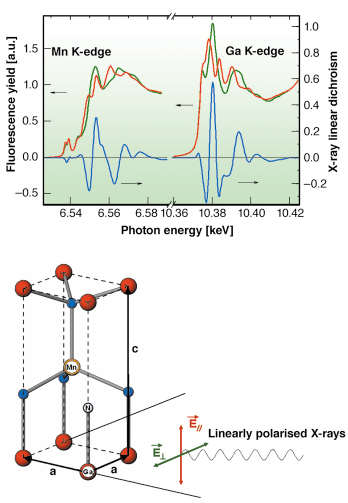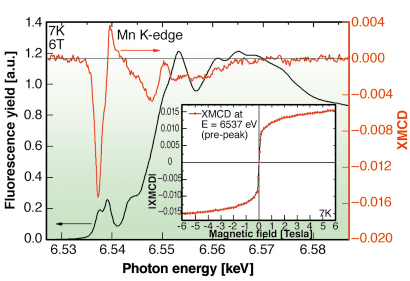- Home
- Users & Science
- Scientific Documentation
- ESRF Highlights
- ESRF Highlights 2006
- X-ray Absorption and Magnetic Scattering
- Hard X-ray dichroism in a ferromagnetic GaMnN wurtzite film
Hard X-ray dichroism in a ferromagnetic GaMnN wurtzite film
The idea of achieving room-temperature ferromagnetism in diluted magnetic semiconductors (DMS) attracts a lot of interest due to DMS importance for developing future “spintronic” devices. One of the most promising systems is GaN diluted with Mn. A ferromagnetic ordering of (Ga,Mn)N at room temperature has been observed by several groups, while others have reported on its paramagnetic behaviour. State-of-the-art characterisation techniques and single-phase (Ga,Mn)N layers are required to clarify the electronic and magnetic properties of Mn atoms, and consequently to reveal the microscopic origin of magnetism that occurs in this DMS.
 |
|
Fig. 111: Experimental configuration for XLD measurements. Normalised experimental XANES spectra (left scale) for linearly polarised X-ray light oriented parallel (red line) and perpendicular (green line) to the c axis and XLD (blue line, right scale) signal recorded at the Mn and Ga K edges for a (Ga,Mn)N epilayer with 6.3% Mn. |
X-ray linear dichroism (XLD) and X-ray magnetic circular dichroism (XMCD) spectroscopies have been used to study the structural, electronic, and magnetic properties of DMS thin films. Since these techniques are element specific, they are the most appropriate tools for directly probing the electronic structure and magnetism of the diluted transition metal. Wurtzite (Ga,Mn)N with 6.3% Mn epilayer film was grown using plasma-assisted molecular beam epitaxy, with standard effusion cells for Ga and Mn, and a radio-frequency plasma cell to supply active nitrogen. XLD and XMCD experiments were performed at beamline ID12. XLD were recorded at both the Mn and the Ga K-edge using a diamond quarter wave plate to convert circularly polarised X-rays into linearly polarised ones. Using the geometry of the experiment shown on Figure 111, the XLD measures the anisotropy of the unoccupied density of states of the 4p shell of the Ga and Mn atoms in the (a,c) plane of the wurtzite structure. The Mn K-edge XLD spectral shape (Figure 111) is very similar to the one observed at the Ga K edge (identical to the Ga K-edge XLD of GaN single crystal), but its amplitude is 1.8 times smaller. This is precisely what one would observe for the Mn atoms in substitution with Ga atoms, whereas for other possible Mn sites occupation, e.g. N-substituted or interstitial sites, the spectral shape and amplitude of XLD signal should be drastically different [1]. Within the detection limit of the method, the presence of any secondary phases or metallic clusters have not been revealed. The XANES spectrum at the Mn K edge in contrast with XLD spectra are quite different from those at the Ga K edge. Two additional peaks at the low-energy side of the absorption edge are observed. These two peaks originate from both quadrupolar (1s ![]() 3d) and dipolar (1s
3d) and dipolar (1s ![]() 4p) transitions reflecting hybridisation of the Mn impurity 4p band with the 3d band located in the GaN gap. The presence of these two peaks in the XANES spectra indicates that the valence state of Mn is mainly 3+ (d4) rather than 2+ (d5), where only one peak is usually observed. To elucidate the microscopic origin of the magnetic behaviour of (Ga,Mn)N, we have performed XMCD measurements at the Mn K edge (Figure 112). A very intense XMCD signal (1.6% with respect to the edge jump) is observed mainly at the first peak of the XANES spectrum. Given the fact that only the orbital magnetisation of the absorbing atom gives rise to the K-edge XMCD signal, our result provides another strong argument in favour of the Mn3+ valence state in wurtzite (Ga,Mn)N. Indeed, in the case of Mn2+ where the 3d and 4p orbital moments are vanishingly small, the XMCD signal is at least one order of magnitude smaller. Moreover, the negative sign of the XMCD signal suggests that the Mn orbital magnetic moment is antiparallel to the applied field and, therefore, to the sample magnetisation. The inset of Figure 112 shows the magnetisation curve recorded by monitoring the Mn K-edge XMCD signal as a function of applied field at 7 K. This magnetisation curve is a typical signature of a ferromagnetic system in the vicinity of a transition temperature. In conclusion, thanks to the element specificity of XLD and XMCD, we have demonstrated that wurtzite (Ga,Mn)N with 6.3% Mn is a intrinsic ferromagnetic DMS with a rather low Curie temperature of only 8K.
4p) transitions reflecting hybridisation of the Mn impurity 4p band with the 3d band located in the GaN gap. The presence of these two peaks in the XANES spectra indicates that the valence state of Mn is mainly 3+ (d4) rather than 2+ (d5), where only one peak is usually observed. To elucidate the microscopic origin of the magnetic behaviour of (Ga,Mn)N, we have performed XMCD measurements at the Mn K edge (Figure 112). A very intense XMCD signal (1.6% with respect to the edge jump) is observed mainly at the first peak of the XANES spectrum. Given the fact that only the orbital magnetisation of the absorbing atom gives rise to the K-edge XMCD signal, our result provides another strong argument in favour of the Mn3+ valence state in wurtzite (Ga,Mn)N. Indeed, in the case of Mn2+ where the 3d and 4p orbital moments are vanishingly small, the XMCD signal is at least one order of magnitude smaller. Moreover, the negative sign of the XMCD signal suggests that the Mn orbital magnetic moment is antiparallel to the applied field and, therefore, to the sample magnetisation. The inset of Figure 112 shows the magnetisation curve recorded by monitoring the Mn K-edge XMCD signal as a function of applied field at 7 K. This magnetisation curve is a typical signature of a ferromagnetic system in the vicinity of a transition temperature. In conclusion, thanks to the element specificity of XLD and XMCD, we have demonstrated that wurtzite (Ga,Mn)N with 6.3% Mn is a intrinsic ferromagnetic DMS with a rather low Curie temperature of only 8K.
 |
|
Fig. 112: Isotropic XANES spectrum (black line, left scale) and corresponding XMCD signal (red line, right scale) recorded at the Mn K edge measured under 6 Tesla in-plane field and at 7 K for a (Ga, Mn)N film with 6.3% Mn. Inset: magnetisation curve measured at 7 K by monitoring the amplitude of the Mn K-edge XMCD signal. |
Reference
[1] F. Wilhelm, E. Sarigiannidou, E. Monroy, A. Rogalev, N. Jaouen, H. Mariette and J. Goulon, AIP Conference Proceedings 879, 1675 (2007).
Principal Publications and Authors
E. Sarigiannidou (a,d), F. Wilhelm (b), E. Monroy (a), R.M. Galera (c), E. Bellet-Amalric (a), A. Rogalev (b), J. Goulon (b), J. Cibert (c), and H. Mariette (a), Phys. Rev. B 74, 041306(R) (2006).
(a) CEA-CNRS-UJF group “Nanophysique et Semiconducteurs”, CEA-Grenoble (France)
(b) ESRF
(c) Institut Néel, Grenoble (France)
(d) INPG, Grenoble (France)



